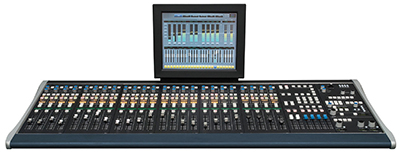Wheatstone’s D-8 Console and the Race to HD

Wheatstone’s D-8 Console
LOUISVILLE, KY.—Every year, we cover the Kentucky Derby horse race with all the fanfare you’d expect of a television operation serving this community. However, this year, we converted our two stations to high-definition operation, running our own version of the Kentucky Derby as we raced against time to be ready for the Kentucky Derby and the May book that followed.
We were on the fast track, with conversion expected to take place within four months—from start to finish. Part of this facility buildout included a new audio console. Our consultant had suggested a Wheatstone D-8 control surface for live news, and I immediately felt comfortable in making that purchase as I’d worked with a Wheatstone product at a previous station and knew it to be very reliable and a good performer. The D-8 digital control surface had everything we needed for live audio mixing with 48 input channels, four submasters, two main buses and two aux buses, plus extensive onboard processing.
AUDIO GOES FIRST
We ordered a 24-channel model to replace an existing analog console and easily had it set up and operational before moving on to larger tasks in our move to high definition.
The D-8 is seeing a lot of use here. We average seven hours of news a day and it’s typical for us to run eight mics at any given time. For example, we’ll air one reporter, follow him or her with two more reporters and then do a final live shot. We run audio from three microwave links into the console, along with a satellite feed, and a streaming box. We’re able to bring in all live resources directly to the console now.
MIX-MINUS IS A BREEZE
What I liked about the older Wheatstone TV-6 I’d worked with—and now this one—is that mix-minus is so easy. We didn’t have mix-minus on our older analog console here, so we had to cheat and use the aux buses. With the Wheatstone D-8, mix minus is easy. You see it, touch it, and it’s out of the mix. This really comes in handy when we have multiple live shots. Also when we need to change sources, we can dial up the source manually and bring it to any fader. Previously, there were limitations on what you could put on a given fader., now we can put any source anywhere. This means that if an operator wants to run mics in the middle of the board, he or she can save the setup and recall it later.
The new Wheatstone D-8 allowed us to complete our conversion on time with very little in the way of problems. The only real issue we had was with audio levels, and as it turned out, this wasn’t a problem with the console at all. After speaking with a Wheatstone field engineer we had the problem resolved in just a few minutes—it turned out to be in the audio embedding process. Overall, we’ve have a very good experience with our D-8 console and the move to digital audio.
The professional video industry's #1 source for news, trends and product and tech information. Sign up below.
David Callan is director of production at Louisville’s WDRB and WMYO television. He may be contacted atdcallan@wdrb.com.
For additional information, contact Wheatstone at 252-638-7000 or visit www.wheatstone.com.
